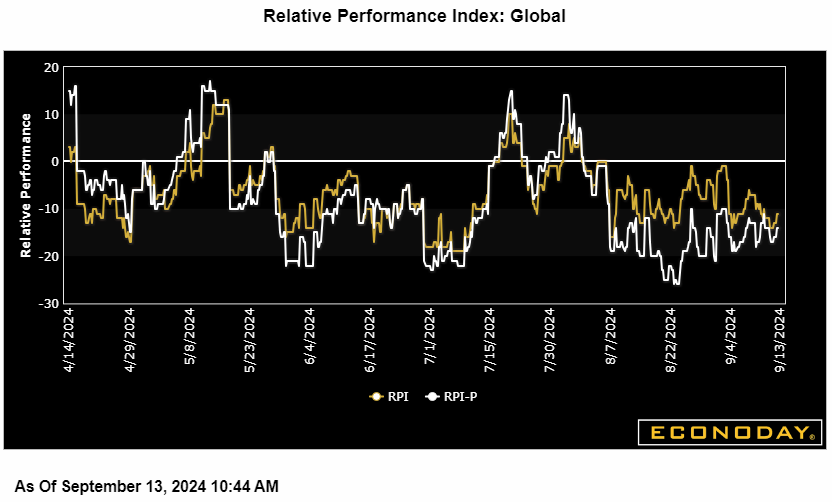Global economic data continue to underperform relative to forecasts. Econoday’s Relative Performance Index (RPI) fell 6 points in the week to minus 16 and edged a further 3 points lower to minus 20 less prices (RPI-P), the latter indicating that real economic activity has been, as it has for the last six weeks, subpar relative to expectations.
By contrast, US data continue to come in very close to Econoday’s consensus estimates, at plus 4 overall and plus 2 excluding prices. Without a bias relative to expectations and with economic growth generally sound, debate at Wednesday’s FOMC, that is whether to cut by 25 or by 50 basis points, looks to be balanced.
There were no significant data releases in Canada last week leaving the RPI at plus 1 and the RPI-P at minus 1. Economic activity is moving in line with generally weak market forecasts for this economy meaning that not only is another 25 basis point ease by the Bank of Canada next month a probability, but even a larger 50 basis point move is at least a possibility.
In the Eurozone, the RPI and RPI-P remain close to zero at minus 3 and minus 12 respectively. However, in effectively meeting market expectations, recent data were still soft enough to justify last week’s 25 basis point cut by the European Central Bank and will underpin speculation about further easing by year-end.
Ahead of Thursday’s Bank of England announcement, Wednesday’s August CPI report could yet tip forecasters towards another cut in Bank Rate. As it is, the economic data have generally surprised modestly on the downside since the last meeting in August, boosting the case of the MPC’s doves. The RPI currently stands at minus 9 and the RPI-P at minus 15.
In Japan, the RPI (minus 40) and, in particular, the RPI-P (minus 61) fell further below zero. The Bank of Japan still looks set to raise interest rates again so long as future inflation meets its expectations but the surprising weakness of recent data strengthen the case for a very cautious approach.
The China RPI and RPI-P fell from minus 36 to minus 43 and from minus 30 to minus 20 respectively, indicating that recent Chinese data, as they have for much of the year, continue to come in well below consensus forecasts.


 Econoday’s Global Economics articles detail the results of each week’s key economic events and offer consensus forecasts for what’s ahead in the coming week. Global Economics is sent via email on Friday Evenings.
Econoday’s Global Economics articles detail the results of each week’s key economic events and offer consensus forecasts for what’s ahead in the coming week. Global Economics is sent via email on Friday Evenings. The Daily Global Economic Review is a daily snapshot of economic events and analysis designed to keep you informed with timely and relevant information. Delivered directly to your inbox at 5:30pm ET each market day.
The Daily Global Economic Review is a daily snapshot of economic events and analysis designed to keep you informed with timely and relevant information. Delivered directly to your inbox at 5:30pm ET each market day. Stay ahead in 2025 with the Econoday Economic Journal! Packed with a comprehensive calendar of key economic events, expert insights, and daily planning tools, it’s the perfect resource for investors, students, and decision-makers.
Stay ahead in 2025 with the Econoday Economic Journal! Packed with a comprehensive calendar of key economic events, expert insights, and daily planning tools, it’s the perfect resource for investors, students, and decision-makers.